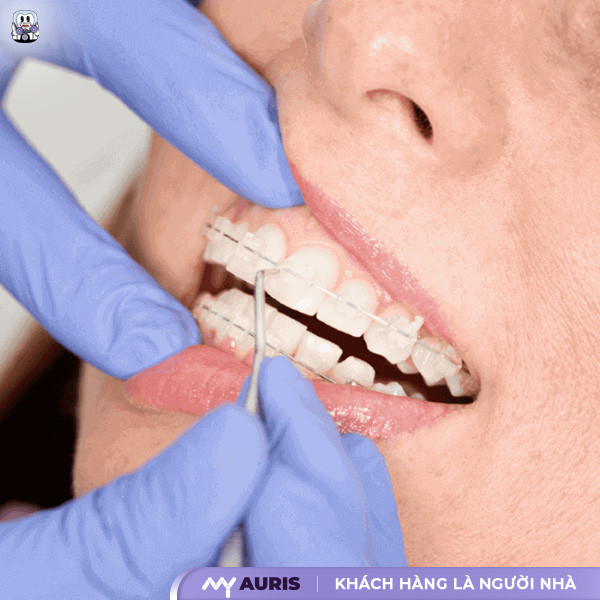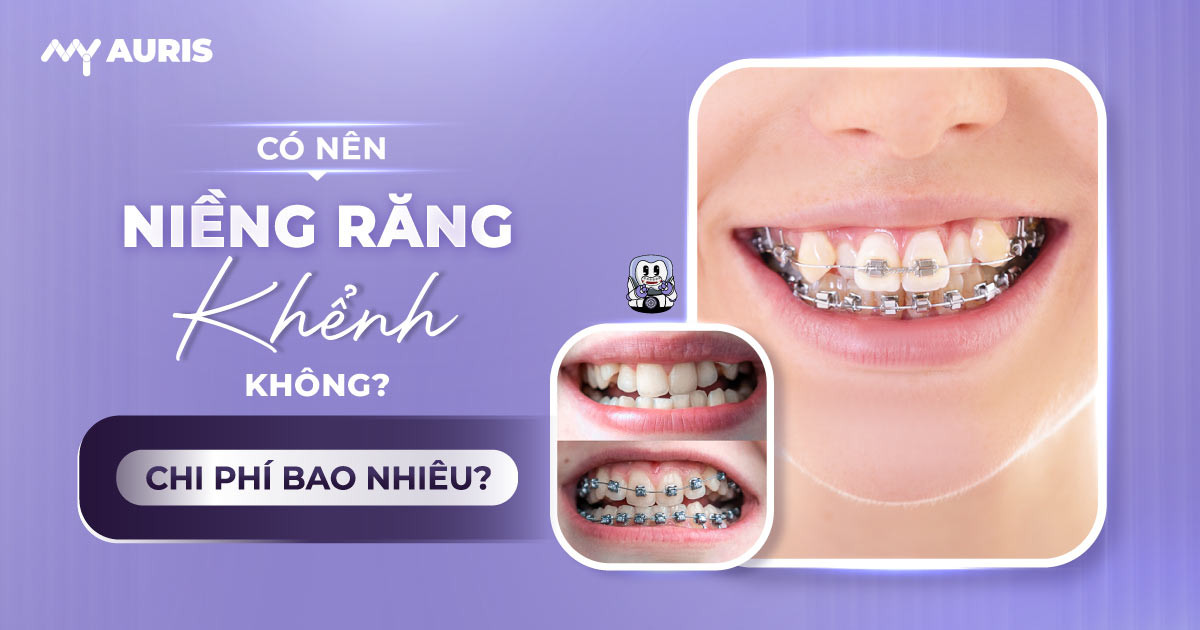Crooked canines are essentially teeth that erupt out of alignment with the dental arch, often crowded with other teeth. This not only reduces chewing function but also increases the risk of oral diseases such as tooth decay, gingivitis, or periodontitis. In many cases, braces are an effective method to straighten teeth, align them properly, and improve both aesthetics and oral health. However, many people still wonder: do braces require crooked canine extraction? If crooked canines are left untreated, will they affect the bite and hinder the bite correction process?
What is Orthodontic Treatment for Crooked Canines?
What is orthodontic treatment for crooked canines? This is an orthodontic method that applies pulling forces from specialized appliances to move misaligned canines – specifically tooth #3, which belongs to the canine group – into their correct position on the jawbone, ensuring both aesthetics and chewing function. Misaligned canines often protrude outside the dental arch, creating a unique feature when smiling but can also lead to long-term inconveniences.
Many people wonder whether to get braces for crooked canines, especially since these teeth are often considered a “charming feature” on the face. In reality, if the benefits of crooked canines are positive – such as them not causing high cheekbones, the remaining teeth in the dental arch being well-aligned, and you genuinely like having them – then it’s perfectly acceptable to keep them to maintain a charming smile and make your face more attractive and impressive.
However, in many cases, orthodontic treatment for crooked canines is recommended if the tooth protrudes excessively, affects the bite, or if other teeth are not properly aligned, thereby hindering chewing, increasing the risk of oral diseases, and even damaging surrounding teeth. Specifically, tooth #3 plays a role in tearing food, and if it’s misaligned, it will reduce chewing efficiency and can lead to temporomandibular joint (TMJ) dysfunction.

Do Braces Require Crooked Canine Extraction?
Whether braces require crooked canine extraction or if orthodontic treatment can be done without extracting crooked canines is a common question for many people interested in cosmetic orthodontics. The decision to keep or remove crooked canines during bracing depends on the specific professional assessment from the dentist.
Based on clinical experience, dentists do not recommend keeping crooked canines if they negatively affect the harmony of the dental arch. During bracing, the dentist will move all misaligned teeth, bring the crooked canines into their correct position, and ensure the bite achieves the standard ratio to optimize both aesthetics and chewing function.
Whether crooked canine extraction is necessary for orthodontic treatment will be determined based on the structure of the dental arch and the degree of misalignment of the crooked canines. In many situations, if the dental arch lacks sufficient space for tooth movement, the dentist will have to recommend extracting crooked canines for braces. In some cases of severe crowding or misalignment, patients may need to extract 4 or even 6 teeth to create appropriate space, helping to align the teeth properly.
However, with modern techniques today, dentists often prioritize supportive measures such as arch expansion, distalization techniques, or interproximal reduction (IPR) to create sufficient space in the dental arch, thereby minimizing the need for tooth extraction for braces.

Notes When Bracing Crooked Canines for the Best Results
Orthodontic treatment for crooked canines not only improves aesthetics but also helps achieve a harmonious bite and protects oral health. However, during the period when teeth are weak, you need to strictly follow your dentist’s instructions to ensure treatment effectiveness and avoid complications.
One of the important notes for bracing crooked canines is to limit hard foods, limit chewy foods like taffy, sugarcane, or hard nuts. Additionally, limit sugary foods such as cakes, candies, and chocolate because these items easily stick to braces, are difficult to clean, and can lead to tooth decay, gingivitis, and periodontitis.
Furthermore, it’s advisable to limit foods that are too hot or too cold, as teeth can be sensitive during this time due to the pulling force of the archwire during the adjustment process.
Prioritize soft, liquid foods like soup, porridge, and green vegetables. Additionally, supplement calcium from milk and dairy products to help strengthen teeth.
You need to brush your teeth thoroughly and correctly as instructed by your dentist. This not only ensures strong teeth but also helps prevent common oral diseases when wearing braces.
If any unusual signs appear, such as severe pain, loose brackets, or bleeding gums, visit your dentist immediately. Do not attempt self-treatment at home, as this can worsen the condition and affect the outcome of your orthodontic treatment.
Regular follow-up appointments as scheduled by the dentist are a crucial factor in controlling the tooth adjustment process. During each visit, the dentist will assess the progress of tooth movement and adjust the pulling force appropriately.
Frequently Asked Questions About Bracing Crooked Canines
How Long Does It Take to Brace Crooked Canines on Both Sides?
How long it takes to brace crooked canines on both sides is a concern for many people before deciding on orthodontic intervention. In reality, the duration for bracing crooked canines typically ranges from 18 to 24 months; however, if the degree of tooth misalignment is more severe, it can take up to 36 months to complete the process of moving the teeth into their correct positions.
However, the speed of the treatment depends on many factors, such as:
- Current oral condition: If teeth are slightly misaligned and the jawbone is stable, the treatment time will be shortened.
- The bracing method you choose: Traditional metal braces, ceramic braces, or Invisalign all have different speeds and effectiveness.
- The expertise of the treating dentist: Highly skilled and experienced dentists will help create an accurate treatment plan and make appropriate adjustments at each stage.
- The patient’s dental care regimen: Good oral hygiene, strict adherence to appointments, and following the dentist’s instructions help the bracing process proceed more smoothly.

How Much Do Braces for Crooked Canines Cost?
How much do braces for crooked canines cost? This is a question many people are interested in when they want to improve their misaligned teeth. In reality, the cost of bracing crooked canines varies for each individual, depending on factors such as the degree of tooth misalignment, the bite condition, and especially the bracing method you choose.
To determine the exact cost of braces, you should visit a reputable dental clinic for a thorough examination by a dentist. Based on the diagnosis, the consulting dentist will propose a treatment plan that suits your needs and financial capabilities.
Below is a reference price list for braces according to popular methods:
Metal Braces: Costs range from 30 – 40 million VND per treatment course, depending on the cost of metal braces and the complexity of the teeth. This is a cost-effective, highly efficient option suitable for many people.
Ceramic/Sapphire Braces: Offering superior aesthetics, this method has a cost of around 40 – 60 million VND per treatment course for ceramic braces and sapphire braces. Treatment courses for ceramic braces and sapphire braces typically last 18 – 24 months.
Invisalign Clear Aligners: The most modern technology available today, providing comfort and being almost invisible. The cost of Invisalign clear aligners is relatively high, ranging from 80 – 100 million VND per treatment course, depending on the number of aligner trays and the specific Invisalign treatment plan.
Does Bracing Crooked Canines Hurt?
“Does bracing crooked canines hurt?” is a common question asked by many people considering improving their dental aesthetics. According to specialists, the bracing process will indeed cause soreness and discomfort, but this feeling occurs in stages rather than continuously.
Typically, the dentist will perform tooth extractions to create space for tooth movement. After extraction, you may feel some swelling and soreness for the first 1 – 2 days. However, this feeling will quickly subside if you follow the dentist’s care instructions.
Next, when braces are first installed, many people are not used to them and may feel awkward, uncomfortable, especially experiencing pain when chewing. However, after some time, you will get used to them and feel more comfortable, and eating will return to normal.
Each time teeth are pulled or tightened, the dentist will tighten the archwire to apply force to move the teeth in the correct direction. This is when you will feel pain for about 5 – 7 days, depending on each individual’s tolerance.
Don’t worry too much! You can eat carefully, limit hard and chewy foods, and pay attention to gentle oral hygiene to reduce discomfort. Once you adapt, you will find that orthodontic treatment is not as painful as you imagined.
Do Braces for Crooked Canines Require Tooth Extraction?
During the examination, if the dental arch does not have enough space for the crooked canines to move into the desired position, tooth extraction may be considered by the dentist to minimize invasiveness and optimize orthodontic effectiveness. Typically, the dentist will extract wisdom teeth or tooth number 4 to create space for the crooked canines to be pulled down to an appropriate position on the dental arch.
However, the final decision regarding tooth extraction will be based on the overall oral health of each patient. The dentist will only proceed once it is confirmed that the extraction will not negatively impact the jaw structure and remaining teeth. Therefore, you should choose a reputable dental clinic with an experienced team of specialists to ensure the orthodontic process is safe and achieves optimal results.
Does Bracing Crooked Canines Affect Health?
According to My Auris dentists, bracing crooked canines, like other types of orthodontic treatments, absolutely does not affect health if performed correctly. Before starting treatment, dentists will conduct a thorough examination and provide detailed consultation before bracing, helping clients understand their oral condition and the most suitable treatment plan.
When misalignment issues are well resolved, teeth will be straight and even, making chewing and oral hygiene easier, thereby better protecting oral health. This is a long-term benefit that many clients notice after completing the bracing process.
For cases of weak teeth or existing oral diseases, the dentist will first perform treatment to eliminate potential risks, and only then proceed with braces. This helps ensure both oral health safety and overall body safety throughout the orthodontic process.





